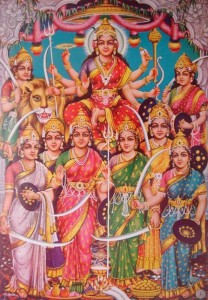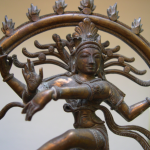I offer this writing and practice around Navaratri, mindful of the religious practices, the mythological and historical context, and also as service to my deep relationship within a specific community. The themes of reconnecting to the self, Divine Mother, and rest are universal, as are the teachings of Durga.
The nine nights of Navratri celebrate and honor the nine different aspects of Mother Divine, Durga in nine manifestations of Shakti. This is the time of deep reflection, of turning inward to restore and renew the body, the heart and breath as the night renews the subtle body. Inviting this withdrawal from sensory activities such as talking and touching, seeing and smelling, and welcoming rest within in yourself takes you deeper within, which is the potent source of bliss, or sattva, that dwells in the home of our hearts.
The world is a busy place. Many of us are coming and going, with the hustle and bustle of a life that doesn’t invite or welcome the spaciousness for rest. Because we are constantly engaged in some activity or another, constantly engaged with the mind, constantly talking. Imagine giving yourself permission for more? Navratri is the more!
Navratri is the potent invitation to transition from the gross material world to the subtle spiritual world. I do this by Looming four evenings practices: Quiet, Abstain, Dyhana, Mantra; by Weaving the the nine aspects of Nava Durga as Divine Mother into my evening meditation, and Restoring my body with 8-10 hours of sleep during the Navaratri period.
I commit to this practice as a reflection of origin, of who we are and where we have come from. Navaratri is the time to withdraw from the mind, and rest in the spirit, or soul. It’s the time to feel the soul and to get reacquainted with the true teacher. You are the true teacher. When we return within, and to rest and restore, in the remembrance of the love of the Divine Mother. It is within in our lives and the spirit within when we connect with Nav Durga and give ourselves the permission to restore.
The Practice: To Loom
Quiet, Abstain, Dyhana, and Mantra
Quiet. What might it be like to choose silence over speech? In a world full of communication sometimes making the conscious choice to be in silence allows the mind to become more perceptive, allowing you to experience deeper relaxation, and create a deeper relationship with the self. For me, I simply commit to being quiet after 8pm. The cell phone is turned to “do not disturb.” I light a candle in my sacred space, and any further sounds I produce are in service to the Divine Mother.
Abstain. Many people fast during Navaratri. Fasting is a tricky thing. I am not a nutritionist or qualified to make recommendations about diet. So, firstly talk to someone who is if you plan to invite a fast or cleanse. For me, it’s less about the food, and more about choosing to abstain from something. You can do this any number of ways and I invite that you explore ways to abstain. Is that your cell phone? Is it Facebook? Too much coffee? I choose to not eat past sundown because I struggle with eating late at night, due to work and then find my ability to rest and slow the body down compromised. Find you what feels right for you.
Dyhana. Meditation is how connect to the True Teacher and to the Divine Mother. Whether you have a dedicated daily practice or this is your first time ever considering inviting a practice. Making space and taking welcoming breath, a grounded seat, and setting an intention is all that matters. The practice is more about welcoming the preparation for your rest, than it is about duration of time. Meditation in the Tantric tradition is about honoring the mind, not silencing it.
Mantra. I welcome sound before I rest with simple chanting. Mantra redirects the mind, and alchemizes the body to prepare for rest. I choose to embrace the sacred sound of Shakti manifesting creation with the sounds Hm-Sa. You breathe in ‘Hmm’, and exhale ‘Saa’ with a sigh-like release.
To Weave: Nav Durga the Divine Mother
The myths and legends of Durga are never ending, 10,000 stories and more. Most of what I glean comes from oral traditions,

my lineage and teachers, Rajanaka Tantra, and an invaluable book, In Praise of the Goddess: The Devimahatmya and Its Meaning, which is accessible as well as exciting to read. With that, here’s a ‘quick and dirty” minus many important characters, names, and faces. The Goddess Durga manifested herself into three major forms namely, Saraswati, Lakshmi and Kali who are the active energies of Brahma, Vishnu and Shiva respectively. These three forms of the Goddess further manifested in three more forms each, thus leading to the nine forms of Durga. It is believed that without these Goddesses the Gods will lose all their powers and have no energy to do anything on their own.
Day 1: Shailaputri, Day 2: Brahmacharini, Day 3: Chandraghanta, Day 4: Kushmanda, Day 5: Skandamata, Day 6: Katyayini, Day 7: Kaalratri Day 8: Mahagauri, Day 9: Siddhidatri
I choose to honor and weave the Nava Durga story in my practice as one manifestation, as the Nava Durga forms are also the life phases of Parvati, consort of Shiva. Here is my retelling.
When Lord Shiva worshipped Maa Adi Parashakti for creation, he cleared different levels of Shakti and the Goddess appeared in saguna, divine immanence, from the left half of Lord Shiva who was called Siddhidatri. Here the Divine Mother dwells within the center of the sun, where Shiva liberated the energy of the sun and She is known as Kashmunda. Soon the Divine Mother appears in the home of Daksha son of Brahma where she stands in the pyres as Brahmacharini. Then she immolates herself manifesting as the daughter of Lord Himalaya is known as Shailaputri.
Rising in her beauty, and she is Mahagauri. When she is married to Lord Shiva, she wears the mantle of Chandra on her forehead and is Chandraghanta. She manifests the child Lord Skanda into her womb and is Skandamata. Destroyer of the demon Mahishasura, She is known as Katyayini. And when she stands is the darkness to fight the demons Shumba-Nishumba, removing her outer golden skin, she is Kaalratri!
She is the Divine Mother. She is the True Teacher. She is Manifestation!
There is the invitation to turn inward and restore the body, To listen to the true teacher, and to discover the wisdom within. Breath to Heart, Heart to Mind, Mind to Body.

















